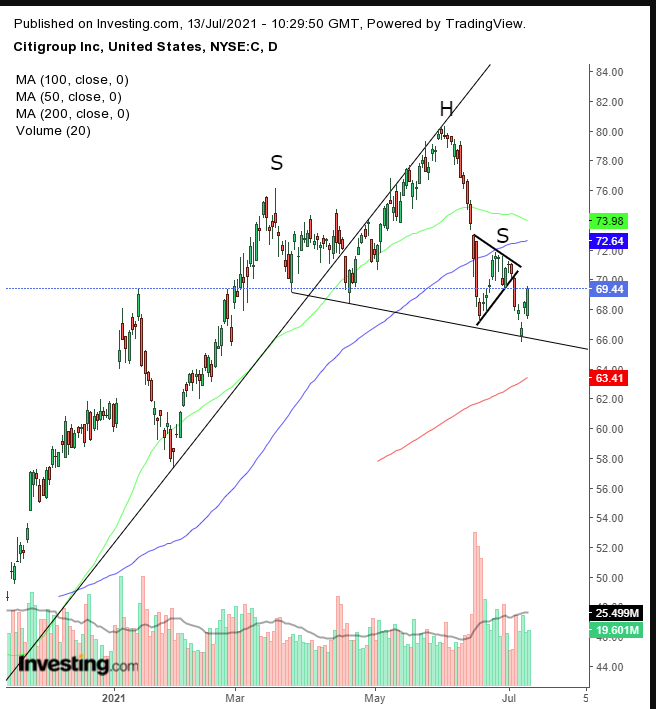Q2 earnings season kicks off today with global investment banks among the first institutions to report. Their results could set the tone for both investor sentiment and whether companies can profit in the current as-yet-untested environment.
Market confidence as well as the broader view on an economic recovery have been wavering, flipping between whether inflation will be transient or persistant, as well as on worries about escalating cases of COVID worldwide as the Delta variant continues its highly contagious run.
That focuses an intense spotlight directly on bank earnings since profitability can be a leading indicator to inflation. Lender fortunes are closely tied to how much interest they can charge, based on the Federal Reserve's own rates.
Fundamentally, banks had a good year. They're flush with cash thanks to record deposit levels during the pandemic’s lockdowns. That allowed the major US lenders to easily pass the government stress tests—enabling many to boost dividends and initiate share buybacks.
Though the financial sector is expected to rally, Citigroup (NYSE:C) is lagging its peers. The country's fourth largest bank reports earnings on Wednesday, July 14, before the bell. Consensus expects the financial institution to have extended the downward spiral in its consumer business.
The megabank is already underperforming the sector, up only 11%, while the Financial Select Sector SPDR® Fund (NYSE:XLF), the ETF that's a proxy for the broader financial sector, more than doubled, soaring 24.5% in the same period.
Investors are already cautious on Citi. It's the only major bank among the six in its category that didn't increase its dividend following the Fed stress tests. Moreover, the bank conceded its capital reserve requirement will rise this year, making any increase in its payout even less likely.
Based on the stock's trading pattern, investors seem to be anticipating disappointment.

First, the stock fell below its uptrend line since the October low. The price attempted to climb back over the line but failed to do so.
Worse, the price then proceeded to fall below its previous low, revealing a lack of integrity to the trend structure. The attempted rally that followed quickly sputtered, then peaking below not only its preceding peak but even beneath the one previous to that, only to follow with a yet another lower low.
This dynamic formed not just any run of the mill H&S top, but one that was downsloping—demonstrating deep structural weakness. That happens when bulls are so tired they can’t even form a right shoulder symmetrical to its left one, allowing a droopy looking pattern to develop.
Note that yesterday’s price was stopped by the left shoulder’s lows, which happened to be exactly at the Jan. 14 high, revealing a technical pressure point. Whichever force—supply or demand—ends up taking this line will likely dominate the battle. A glance at the volume easily reveals where the force is, among sellers on red days.
Meanwhile, the price fell through both the 50- and the 100-DMAs. The 50-DMA already curved downward, threatening to cut through the 100-DMA in a display of weakness. The 200-DMA is rising to support the neckline, which will likely be the last test before the price tops out.
The wider view is even more evocative:

This view makes it easy to understand why the price descended from its May $80 peak. It had reached the top of its rising channel since the 2020 bottom. That was a good run within the narrower (green) rising channel since the October low, which was visible on the daily chart.
However, profit-taking reduced demand and increased supply, pushing the price below its faster-rising channel, now setting it on course to return to its technical mean, the bottom of the broader, slower (orange) rising channel since the 2020 low.
This dynamic, in which prices rise with increasing demand, then falling when demand wanes and supply takes over upon profit-taking, is what creates a rising channel. So, if the H&S completes, with a downside breakout, it would constitute a short- to medium-term downtrend. The long-term, however, would remain up.
Trading Strategies
Conservative traders should wait for the price to fall and retest the long-term rising channel—or alternatively, break above it in case of a H&S blowout—before risking a long position.
Moderate traders would short upon a decisive downside breakout of the H&S top.
Aggressive traders could short at will, counting on the bearish pennant, toward which the price is now performing a return move, provided they operate according to a trading plan that justifies the risk. Here’s an example:
Trade Sample
- Entry: $69
- Stop-Loss: $72
- Risk: $3
- Target: $60
- Reward: $9
- Risk:Reward Ratio: 1:3
